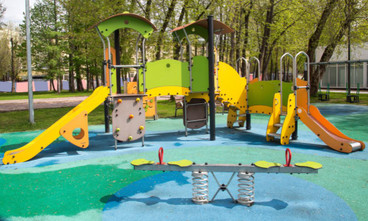It’s essential to know what to do when you have damaged playground surfaces. Take the time today to learn the basics of playground surfacing repair so that you and your maintenance crew are prepared to manage any surfacing problems.
What Type of Playground Surfacing Do You Have?
Playground surfacing is an essential part of the playground. It serves both aesthetic and safety purposes. For these reasons, you need to know what type of surfacing your playground has. The main types of flooring are loose-fill and unitary.
Here’s what unitary surfacing includes:
- Bonded rubber
- Interlocked tiles
- Poured rubber
As for loose-fill material, this is what it consists of:
- Wood mulch
- Loose-fill rubber
- Rubber mulch
Unitary Surfacing
Let’s start with learning how to repair, clean, and inspect unitary surfacing. While this post is about the basics of repairing playground surfacing, it’s beneficial to know how to inspect each zone before making repairs.
Inspect
Compared to loose-fill surfacing, inspecting unitary surfacing is easier because you don’t need to rake through it to find debris, trash, or abandoned toys. Perform a weekly walkthrough and look for cracks, pits, stains, and scratches.
Repair
When repairing playground flooring, make sure the area is blocked off so no one accidentally wanders through the work zone. Using your best tools, patch and repair the areas with the most issues. The best way to know if your grounds need repairs is by looking for rips and snags on the surface.
If you find snags and tears, try using poured rubber playground flooring to fix the holes. Next, use a paint roller to smooth the surface. Finally, seal it off with a cover.
Loose-Fill Surfacing
Knowing how to repair, clean, and inspect loose-fill surfaces is also important.
Inspect
Don’t put in new material until you’ve examined what you currently have. First, go through every part of the play area with a rake or leaf blower to move the surfacing around and check for hazardous items. Make sure to wear gloves and bring along a garbage bag to store all debris before touching up the flooring.
Repair
Repairing loose-fill surfacing isn’t too difficult. Fill any dips with the exact amount of loose-fill material so that the ground evens out. You should ensure the fills are at least twelve inches deep before finishing repairs.
Park maintenance crews need to keep the playgrounds surfacing hazard-free. Administrators can do their part to ensure the crews have a list of things to do when inspecting and repairing surfacing. Let Discount Playground Supply help you further by providing playground rubber surfacing and other repair kits to improve the play area. Browse our online store for more ways to enhance the playground.

